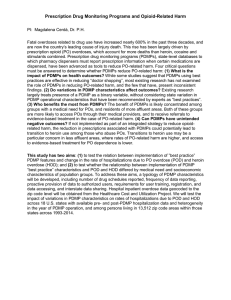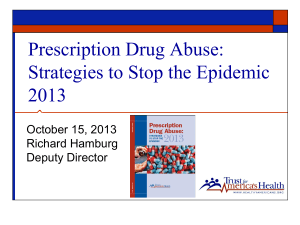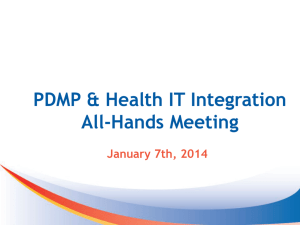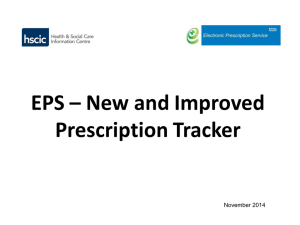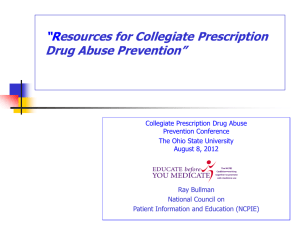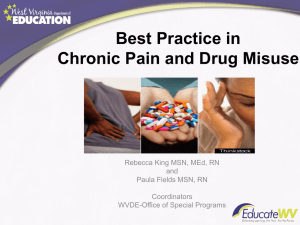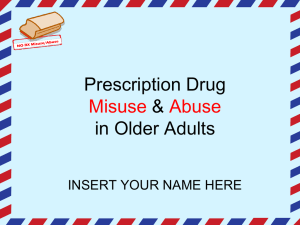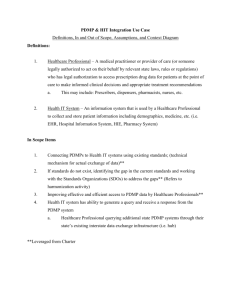SAMHSA Powerpoint Template
advertisement
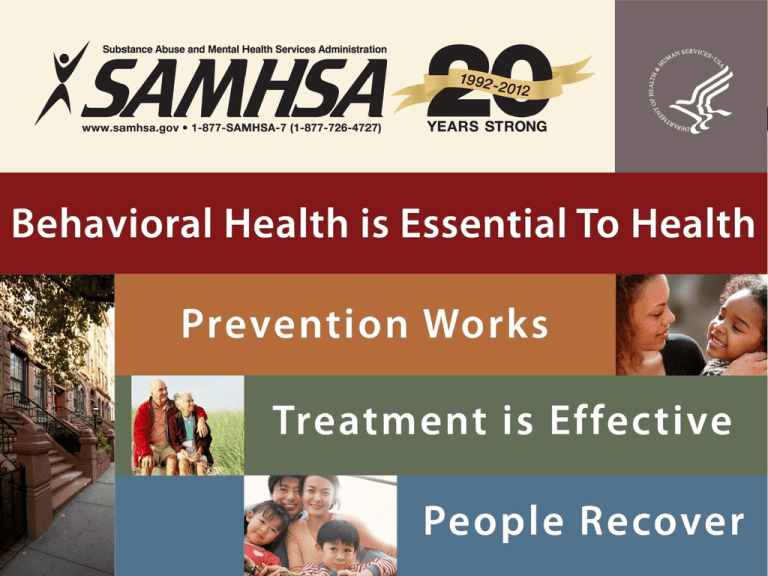
What you need to know about Prescription Drug Monitoring Programs Jennifer Fan, PharmD, JD Jinhee Lee, PharmD Division of Workplace Programs Division of Pharmacologic Therapies Center for Substance Abuse Prevention Center for Substance Abuse Treatment 2012 USPHS Scientific and Training Symposium Disclosure Statement • The presenters for this session, Jennifer Fan and Jinhee Lee, have disclosed no relevant, real or apparent personal or professional financial relationships. Outline • • • • PDMPs: The Context PDMPs: Description and Update Current System: Advantages and Limitations PDMPs and Patient Confidentiality: 42 CFR Part2 • Integrating PDMPs into practice 1. PDMPS: THE CONTEXT The Problem • The CDC* has declared that the U.S. is in the midst of an epidemic of prescription painkiller overdose deaths. Deaths from these drugs now outnumber deaths from heroin and cocaine combined. *Centers for Disease Control and Prevention Past Month Illicit Drug Use among Persons Aged 12 or Older: 2010 Source: 2010 NSDUH 1 Illicit Drugs include marijuana/hashish, cocaine (including crack), heroin, hallucinogens, inhalants, or prescription-type psychotherapeutics used nonmedically. Challenges • In 2010, an estimated 22.1 million persons– 8.7% of the U.S. population aged 12 or older -- were classified with substance abuse or dependence. – 2.2 million reported past year dependence or abuse of psychotherapeutics (non-medical use) – 1.9 million of them for pain relievers • 20.4% persons reported non-medical use of psychotherapeutics at sometime during their lifetime – 13.7% reporting non-medical use of pain relievers, and • 2 million people (12 or older) initiated illicit use of pain relievers during 2010, second only to those who initiated marijuana use (2.4 million) Source: 2010 NSDUH Low Perception of Risk • Prescription drugs obtained from a medicine cabinet or pharmacy are perceived to be less addictive and not as dangerous as illegal drugs obtained from a drug dealer. • Teens’ perception of the risks associated with abusing prescription drugs is relatively low. • Low perception of risk, coupled with easy availability, is a recipe for an ongoing problem. Source Where Pain Relievers Were Obtained for Most Recent Nonmedical Use among Past Year Users Aged 12 or Older: 2010 Source Where Respondent Obtained More than One Doctor (2.1%) One Doctor (17.3%) Other1 (4.6%) Bought on Internet (0.4%) Drug Dealer/ Stranger (4.4%) Bought/Took from Friend/Relative (16.2%) Source: NSDUH 2010 1The Source Where Friend/Relative Obtained Free from Friend/ Relative (55.0%) More than One Doctor (3.6%) One Doctor (79.4%) Free from Friend/Relative (6.3%) Bought/Took from Friend/Relative (6.5%) Drug Dealer/ Stranger (2.3%) Bought on Internet (0.2%) Other1 (1.7%) Other category includes the sources "Wrote Fake Prescription," "Stole from Doctor’s Office/Clinic/Hospital/Pharmacy," and "Some Other Way." 10 Federal Strategy to Address the Problem of Prescription Drug Abuse • Prescription Drug Abuse Prevention Plan released by the White House in April 2011 – – – – Educate patients and healthcare providers Increase use of PDMPs Implement and promote use of Rx drug disposal programs Support law enforcement efforts against illegal prescribing • 2011,2012 National Drug Control Strategy SAMHSA’s Strategic Initiatives • • • • • • • • Prevention of Substance Abuse & Mental Illness Trauma and Justice Military Families Recovery Support Health Reform Health Information Technology Data, Outcomes, and Quality Public Awareness and Support 2. PDMPS: DESCRIPTION AND UPDATE What is a PDMP? • Description – Collect, manage, analyze, and provide prescription data under the auspices of a state, territory, district, or commonwealth • Purpose – Tool for curtailing drug abuse and diversion while ensuring controlled substance access to patients with legitimate medical need Courtesy of Dave Hopkins , Alliance of States of Prescription Monitoring Programs PDMP Goals • Ensure access to controlled substances for legitimate medical purposes • Provide education and information regarding drug abuse and diversion issues • Support public health initiatives • Identify potential misuse and abuse to support early intervention and treatment • Enable more efficient investigation and enforcement Courtesy of Dave Hopkins , Alliance of States of Prescription Monitoring Programs PDMP History • First PDMPs – 1939 – 1943 – California, Hawaii – 1972 – 1990 – New York, Washington, Texas, Illinois, Michigan, Rhode Island, Indiana • Duplicate/Triplicate Prescription Forms • 1991 – Oklahoma first electronic program Federal Programs • Harold Rogers Prescription Drug Monitoring Program (Department of Justice) • National All Schedules Prescription Electronic Reporting Program (NASPER) (Substance Abuse and Mental Health Administration) • The Enhancing Access to PDMP project sponsored by ONC and funded by SAMHSA The Story So Far Federal & State Partners Action Plan State Participants Stakeholders White House Roundtable on Health IT & Prescription Drug Abuse June 3, 2011 Organizations Enhancing Access to Prescription Drug Monitoring Programs • Use health IT to increase timely access to PDMP data in an effort to reduce prescription drug misuses and overdoses. – Develop the standards and policies necessary to connect existing health information technologies to increase timely use of PDMP data by providers, emergency department providers, and pharmacists. Research is current as of May 30, 2012. http://www.namsdl.org/documents/PMPProgramStatus05302012.pdf What Agency Administers the PDMP in each State? • Type of state agencies that administer the PDMP: – Consumer Protection – 1 – Substance Abuse – 2 – Law Enforcement – 7 – Professional Licensing – 5 – Departments of Health – 16 – Boards of Pharmacy – 18 Source: Dave Hopkins, Alliance of States of Prescription Monitoring Programs Drug Schedules Monitored Schedules Collected States Number Schedule II PA 1 Schedules II-III RI, WI 2 Schedules II-IV AZ, CA, FL, IA, KS, ME, MN, NV, NJ, NM, OR, SC, SD, VT, VA, WV, WY 17 Schedules II-V AK, AL, AR, CO, CT, DE, GA, Guam, HI, ID, IL, IN, KY, LA, MA, MI, MS, NY, NC, ND, MD, MT, OH, OK, TN, TX, UT, WA 28 To be determined NE 1 Source: Alliance of States of Prescription Monitoring Programs, www.pmpalliance.org PDMP Data Collection Frequency • • • • Daily – 3 States Weekly – 20 States Bi-Weekly – 11 States Monthly – 5 States Source: Alliance of States of Prescription Monitoring Programs, www.pmpalliance.org Prescription Information Collected • • • • Patient Information – Name, address, date of birth, gender, method of payment Prescriber Information – DEA registration number – Date Rx issued Dispenser Information – DEA registration number – Date Rx dispensed Drug Information – National Drug Code (drug name, type, strength, manufacturer) – Quantity – Days supply – New or refill Source: Dave Hopkins, Alliance of States of Prescription Monitoring Programs Types of PDMP Reports • Typical PDMP reports include: – Patient – Prescriber – Pharmacy • Solicited – all PDMPs (except PA) • Unsolicited – not all states • States may also run specialized reports (e.g., by drug or region) Source: Dave Hopkins, Alliance of States of Prescription Monitoring Programs Who is authorized to Request Patient Rx Data? • • • • • • • Prescribers Pharmacists Pharmacies Law Enforcement Licensing Boards Patients Others Source: Dave Hopkins, Alliance of States of Prescription Monitoring Programs, www.pmpalliance.org 3. CURRENT SYSTEM: ADVANTAGES & LIMITATIONS Advantages • Inappropriate use of Rx drugs can lead to: o Treatment failure o Drug-drug interactions o OD and death • PDMP = invaluable tool: o Patient monitoring o Treatment planning o Risk management Issue • PDMPs collect a considerable amount of useful information but utilization of these programs in unacceptably low Limitations • Some states do not have PDMPs yet, though most do (49 states with legislation, 42 operational) • Lack of interoperable PDMPs to enable crossState checks • PDMPs are only one part of the effort to reduce prescription drug abuse Limitations (cont) • • • • Time lag between Rx and reporting “Extra” burden on provider Potential errors (FP/FN) Providers are only able to view some of their patient’s Rx data • Policy and technical standards – vary from state to state • Some states do not allow for unsolicited reporting (e.g. real-time push to prescribers via Direct messaging) 4. PDMPS AND PATIENT CONFIDENTIALITY: 42 CFR PART2 Confidentiality: 42 CFR Part 2 • 42 CFR Part 2 enacted by Congress • To protect confidentiality of patients receiving treatment for alcohol/substance use disorders by federally-assisted programs* • Because stigma associated with substance abuse and fear of prosecution deter people to enter treatment Confidentiality (cont) • Disclosure of patient-identifying information is permitted with written patient consent • BUT redisclosure of such information is prohibited PDMPs and 42 CFR Part 2 • Accessing patient information from PDMP disclosure of patient information • Patient consent is NOT required to access PDMP • Notifying patient that PDMP will be checked is, however, encouraged PDMPs and 42 CFR Part 2 (cont) • PDMPs disclose patient information to authorized providers • PDMPs do not fall under 42 CFR, part 2 • THUS, if information is entered in PDMPs, it could be redisclosed • If under 42 CFR, Part 2: Do NOT disclose patient information to PDMPs PDMPs and 42 CFR, Part 2 (cont) • Once Rx is issued and either sent through electronic means or given to patient, no longer protected by 42 CFR, part 2 • Rx information (buprenorphine) will be entered in PDMP by pharmacists • Consider clarifying this with patient 5. INTEGRATING PDMPS INTO PRACTICE Integrating PDMPs into practice • Illicit use of prescription drugs (i.e., opioids, stimulants, and sedatives) has reached epidemic level • Drug-drug interactions and increased risk of overdose in patients abusing rx drugs • Self-report and U. Toxicology might not tell the whole story, in particular with Rx drugs Case study (March 2011) • Setting: Large outpatient OTP • Data: PDMP report on all patients • Results: ~ 23% of patients, unknown to clinical staff, were Rx significant quantities of opioids, benzodiazepines, and other controlled substances by providers outside the clinic Case study-March 2011 (cont) • Patients were advised that successful treatment and their own treatment required they d/c seeking unauthorized or duplicate Rx • Most patients complied and were retained in treatment , subject to ongoing monitoring of State’s PDMP • “I consider the database as one of the best tools I have to help identify and treat opioid addiction” Barriers • Time lag: “I have called these pharmacies to explain why it is important to me they participate in the PDMP “ • Technology: “I ‘m not particularly computer savvy, but it didn’t take long to become proficient in checking the database “ • Time: “ I can check a patient in about 20 seconds, though much more time is required if I find any prescriptions” Rx drug abuse: Epidemic & Risks overlooked “Since most patients (…) in our State are addicted to Rx opioids (…) goldmine of information. Many (…) got at least part of their opioids by RX from doctors and were often Rx other (…) often did not seem to realize how addictive and dangerous Rx drugs can be (…)” Rx drug abuse: Epidemic & Risks overlooked (cont) “Methadone, oxcycontin, fentanyl, or relatively large amount of benzodiazepines (…) mostly alprazolam, diazepam, or clonazepam . Some patients … taking these Rx, and found methods to avoid detection on observed urine screens (…) some (…) giving (…) selling them. None of their community-based doctors knew (…) No one at our treatment center knew (…) prior to … PMP.” Intervention • • • • Sign up for your State PDMP Get familiar with system and limitations Check PDMP on all new and current patients Tailor PDMP monitoring based on patient’s risk profile (as you do with U. Tox) • Inform patients through general notice, individual notice, patient agreement Intervention (cont) • Confront patient if get unexpected report • Explore if for own use and/or diversion • Question if patient gets Rx drugs from other sources (out-of-state, friends or family, dealer) • Discuss risks associated with use/diversion • Obtain consent to talk with prescribing doctors Intervention (cont) • Establish clear practice guidelines in case of unexpected report: Patient agrees to sign consent and subsequent checks are negative Patient denies to sign consent but subsequent checks are negative Patient misuses drugs and continues to have positive checks Patient diverts Rx and continues to have positive checks Patient states report is inaccurate Intervention (cont) “As long as the patient agreed to stop getting other opioids, they could stay in treatment with us, and the patient was better off. Many such patients later said they were glad this had happened. They said it burned the bridge of access to drugs they often misused.” Intervention (cont) • Safety should always be #1 driver in treatment • Keep countertransferance in balance and treatment goal in perspective “Thirty or forty patients on take home level five or six were found to be furtively obtaining methadone or Oxycontin or fentanyl, and I felt their deception was greater.” (Case study OTP Medical Director) Individual and PH outcomes • Improved treatment outcomes • Reduced risk of overdose and death • Reduced diversion and risk of Rx drug abuse (over 70% of Rx drugs abused are obtained from family/friends) Supporting evidence • National comparison b/w states with vs. without PDMPs between 1993-2003 showed : Slower growth in per capita availability of scheduled II pain relievers and stimulants in states with PDMPs PDMPs reduces probability of abuse of those drugs (lower rates of treatment admissions than anticipated) Difference more pronounced for proactive (unsolicited reports) vs. reactive PDMP systems Simeone & Holland, 2006 (http://www.simeoneassociates.com/simeone3.pdf) Supporting evidence (cont) • National analysis of poison center data of states with vs. without PDMPs, 2003-2009, found 12% vs. 4.5% decrease in calls related to intentional exposure to long acting opioids 4.1% decrease vs. 4.1% increase in calls related to intentional exposures to immediate release opioids Reifler, 2010 (http://rmpdc.org/Portals/23/Poster%20PC%20rates%20for%20PMP-LAOs%2015SEP10.pdf ) • PDMPs impact prescribers practices: Study conducted in ED in OH in summer of 2008: - 18 providers, 179 patients with painful conditions (not acute injuries) - Median Rx for pain relievers in last 12 mos was 7 (0-128) - Providers altered Rx based on PDMPs report for 41% (74) of cases - 61% (45) were Rx no or fewer narcotics and 39% (29) more than originally planned Baehren et al., Ann Emerg Med, 2010 Supporting evidence (cont) • 2010 KASPER (KT PDMP) Satisfaction Survey: Question: “To what extent do you feel KASPER is an effective tool to keep track of an individual’s scheduled prescription drug history?” Response: 96.4% responded “very effective” or “somewhat effective”, 1% “neutral”, and 0.7% “somewhat ineffective”; none “very ineffective” http://chfs.ky.gov/NR/rdonlyres/BDC0DFC9-924B-4F11-A10A5EB17933FDDB/0/2010KASPERSatisfactionSurveyExecutiveSummary.pdf For more… • PDMPs: Alliance of States with PMPs: http://www.pmpalliance.org/ PMP Center of Excellence: http://pmpexcellence.org/ National Alliance for Model State Drug Laws: http://www.namsdl.org/home.htm Dear Colleague letter: http://www.dpt.samhsa.gov/pdf/pmp_otp_2011_letter.pdf • 42 CFR Part 2: FAQs 2010 - HIT: http://www.samhsa.gov/healthPrivacy/docs/EHR-FAQs.pdf FAQs 2011 – FAQs revised: http://www.samhsa.gov/about/laws/SAMHSA_42CFRPART2FAQII_Revised.pdf Contact Information • Jennifer Fan – jennifer.fan@samhsa.hhs.gov • Jinhee Lee – jinhee.lee@samhsa.hhs.gov Questions?
